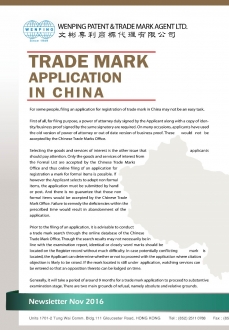For some people, filing an application for registration of trade mark in China may not be an easy task.
First of all, for filing purpose, a power of attorney duly signed by the Applicant along with a copy of identity/business proof signed by the same signatory are required. On many occasions, applicants have used the old version of power of attorney or out of date version of business proof. These would not be accepted by the Chinese Trade Marks Office.
Selecting the goods and services of interest is the other issue that applicants should pay attention. Only the goods and services of interest from the Formal List are accepted by the Chinese Trade Marks Office and thus online filing of an application for registration a mark for formal items is possible. If however the Applicant selects to adopt non formal items, the application must be submitted by hand or post. And there is no guarantee that those non formal items would be accepted by the Chinese Trade Mark Office. Failure to remedy the deficiencies within the prescribed time would result in abandonment of the application.
Prior to the filing of an application, it is advisable to conduct a trade mark search through the online database of the Chinese Trade Mark Office. Though the search results may not necessarily be in line with the examination report, identical or closely word marks should be located on the Register record without much difficulty. In case potentially conflicting mark is located, the Applicant can determine whether or not to proceed with the application where citation objection is likely to be raised. If the mark located is still under application, watching services can be entered so that an opposition thereto can be lodged on time.
Generally, it will take a period of around 9 months for a trade mark application to proceed to substantive examination stage. There are two main grounds of refusal, namely absolute and relative grounds.
Absolute ground for refusal is mainly concerned about the mark itself which is regarded as indistinctive for registration. For those marks containing common term or geographical name, the Applicant should delete such an objectionable feature from the mark prior to the filing. Otherwise, the mark may attract absolute ground for refusal at the examination stage.
Relative ground for refusal is concerned about conflicting marks for relevant goods and services of interest. As mentioned earlier, a trade mark search prior to the filing may help you formulate an effective measure to deal with this relative ground for refusal at the earlier stage. You may start preparing the opposition proceedings or institute cancellation action against the conflicting mark wherever appropriate. Bearing in mind these proceedings are separate from the procedure for the trade mark application and the Review Board may not allow to withhold the procedure pending outcome of the proceedings. It is advisable to institute those contentious actions against the potentially conflicting mark as earlier as possible.
In case the Applicant is not satisfied with the findings in the notice of examination report, he or she may lodge a review with the Chinese Trademark Review and Adjudication Board ( CTRAB ) within fifteen days from the date of receipt of the notice. And the Applicant is required to submit another set of Power of Attorney and copy business proof. User evidence in China will help support a case that the mark itself has established prior rights there.
Last but not least, it should be noted that the one who files his or her application earlier will have the priority to proceed to registration first. It is therefore important one should file his application with the Chinese Trade Mark Office as soon as he can, in order to avoid any co-pending application or bad faith filing.


